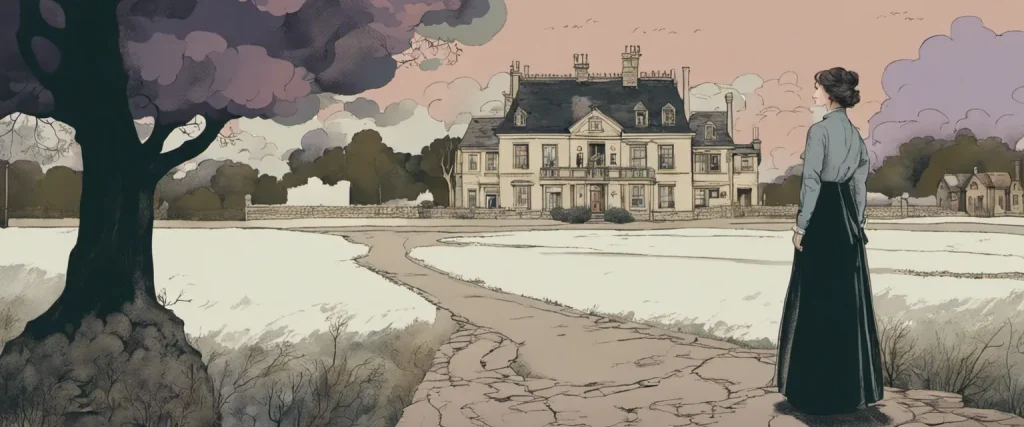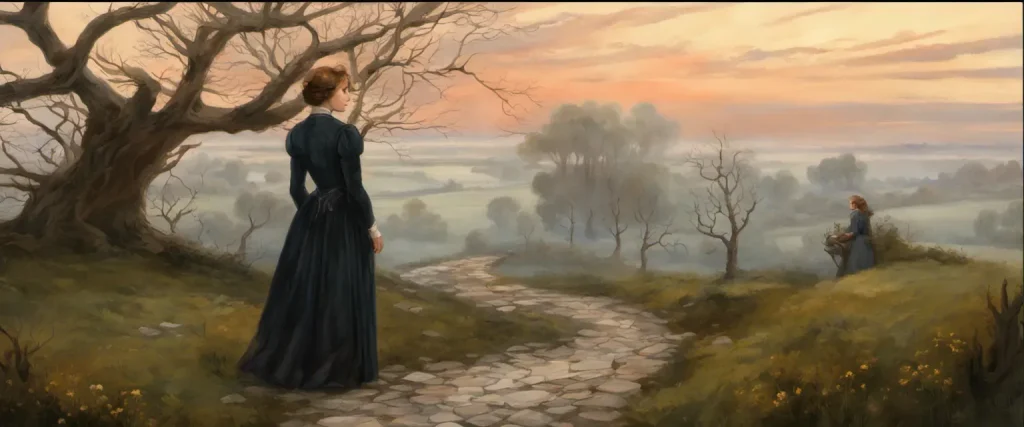In Charlotte Bronte’s timeless novel, “Jane Eyre,” the life of the eponymous protagonist unfolds with equal measures of resilience and passion. Born into a bleak and oppressive existence, Jane endures both emotional and physical hardships throughout her upbringing. Bronte masterfully weaves a narrative of self-discovery, love, and societal upheaval, presenting readers with a captivating tale that has resonated with audiences for over a century. Charlotte Bronte, born in 1816, was one of the most notable Victorian-era English novelists. Alongside her famous sisters, Emily and Anne, Charlotte contributed significantly to the literary landscape with her unique blend of realism and gothic elements. Through her vivid storytelling, Bronte challenged societal norms and brought to life complex characters grappling with their inner desires. Her literary legacy continues to captivate readers, stamping her mark as one of the seminal voices in English literature.
Chapter 1: Childhood and Orphanhood
Chapter 1 of “Jane Eyre” by Charlotte Bronte introduces us to the protagonist, Jane Eyre, and details her childhood and orphanhood experiences. The chapter begins with Jane Eyre, a ten-year-old orphan, living under the care of her Aunt Reed. Jane is mistreated by her aunt and her cousin, John Reed, who frequently bully and abuse her.
The chapter delves into Jane’s emotions and her struggle to find her place in her hostile environment. Despite her harsh treatment, Jane possesses a strong sense of self and refuses to succumb to her aunt’s unkindness. She seeks solace in books and introspection, allowing her imagination to transport her to different worlds where she can escape her current circumstances.
Jane’s cousin, John Reed, is portrayed as a cruel and arrogant child who torments her. The mistreatment culminates in a violent incident when Jane reacts defiantly to John’s abuse, leading him to physically attack her. Following this event, Jane’s aunt punishes her by locking her in the eerie Red Room, the chamber where Jane’s uncle died a year prior. Jane’s isolation and imagination lead her to envision her uncle’s ghost, causing her to pass out from fear.
When Jane regains consciousness, she finds herself in the care of the kindly servant, Bessie, and her nurse, Miss Abbot. Jane is informed that her punishment in the Red Room was due to her uncle’s ghost scaring her aunt, resulting in Jane being blamed for the disturbance. Jane’s disdain for her aunt grows stronger, and she yearns for a sense of belonging, prompting her to wonder about her family and the possibility of other relatives.
In this opening chapter, Bronte effectively establishes the themes of mistreatment, resilience, imagination, and Jane’s longing for love and acceptance. These themes will continue to shape Jane’s journey throughout the rest of the novel.
Chapter 2: Lowood School
In Chapter 2 of “Jane Eyre” by Charlotte Bronte, the narrative shifts to Lowood School, a charity institution where Jane is sent after her time with the Reeds. The chapter begins with Jane’s journey to the school, describing the cold and desolate landscape she encounters.
Upon arrival, Jane is introduced to Mr. Brocklehurst, the stern and hypocritical headmaster of Lowood. He questions Jane about her religious beliefs and criticizes her appearance and upbringing, making her feel even more inferior. Jane’s defiance and honesty in response to his condescending remarks surprise and impress Miss Temple, one of the teachers, who defends her.
Jane soon encounters other girls at Lowood, many of whom are orphaned or from poor families. She befriends Helen Burns, a quiet and pious girl who becomes her closest companion. Helen’s patience and resilience greatly influence Jane, teaching her to endure her hardships with grace. Jane also becomes aware of the harsh discipline and lack of proper nutrition at the school, with girls often suffering from hunger and cold.
Jane’s first months at Lowood pass with a mixture of challenging lessons, strict routines, and the comfort of Helen’s friendship. However, a typhus outbreak strikes the school, resulting in the deaths of several girls and further deteriorating the already bleak conditions.
Despite these hardships, Jane’s spirits are lifted when Mr. Lloyd, a kind apothecary, visits and examines her. She learns that he has communicated with her uncle, who wishes to provide financial support for her. This revelation brings a sense of hope and the prospect of a brighter future for Jane.
Chapter 2 of “Jane Eyre” portrays the oppressive and harsh environment of Lowood School, but also introduces some key relationships and moments that shape Jane’s character and resilience.
Chapter 3: Growing Up at Lowood
Chapter 3 of “Jane Eyre” by Charlotte Bronte introduces the readers to Lowood Institution, a charity school where Jane is sent after her traumatic experience at Gateshead Hall. Lowood is a strict and harsh school, but it provides opportunities for education and a sense of stability in Jane’s life.
Upon arrival at Lowood, Jane and the other students are inspected by the headmaster, Mr. Brocklehurst, a severe and unyielding man. He preaches about the importance of self-denial, poverty, and teaching the girls to live a pious and humble life. Mr. Brocklehurst’s austere regime includes meager meals, plain clothing, and intense discipline that often leads to cruelty and neglect.
Jane’s first impression of the school is one of discomfort and loneliness, but she quickly forms a friendship with Helen Burns, a pensive and patient girl. Helen becomes Jane’s guide and confidante, offering solace during their shared experiences of hardship. Helen’s philosophy is one of acceptance and embracing suffering as a path to salvation.
Jane’s time at Lowood is marked by arduous learning and rigid conditions, including bitter cold during winter. The harsh conditions eventually lead to an outbreak of infectious typhus fever. Both Helen and Jane fall ill, but Helen’s condition worsens, and she eventually dies.
Despite the hardships and the loss of her dear friend, Jane manages to excel academically and earns the respect of her teachers. With the help of Miss Temple, a kind and understanding teacher, Jane’s talent and determination are recognized, allowing her to become a teacher at Lowood after finishing her studies.
Chapter 3 illustrates Jane’s resilience and her ability to find solace in companionship during difficult times. It sets the stage for Jane’s personal growth and foreshadows her future as an independent and self-sufficient woman.
Chapter 4: Thornfield Hall
In Chapter 4, titled “Thornfield Hall,” of Charlotte Bronte’s classic novel Jane Eyre, the story unfolds as the orphaned protagonist, Jane Eyre, heads to a new location to work as a governess in the secluded Thornfield Hall. Jane’s journey to Thornfield is arduous and lengthy, taking her through gloomy landscapes and deserted roads, which deepen the sense of mystery surrounding her new employment.
Upon arrival, Jane is greeted by Mrs. Fairfax, the housekeeper, who kindly shows her to her modest accommodation. Jane’s first impression of Thornfield Hall is one of fascination, as she discovers the numerous hidden nooks and crannies of the labyrinthine building. Mrs. Fairfax also divulges some information about the enigmatic owner, Mr. Rochester, who is a rarely seen and seemingly stern man.
While settling into her new role, Jane meets Adele, a vivacious French girl whom she is to instruct. Adele’s existence at Thornfield raises questions about her relationship to Mr. Rochester. Jane is determined to uncover the secrets of the manor and its dwellers, especially Mr. Rochester, as she finds herself increasingly captivated by the intense atmosphere pervading Thornfield.
One evening, as Jane sits alone in the drawing-room, she hears an eerie and inexplicable noise, which causes her to question the nature of the place she has entered. The chapter concludes with the chilling realization that there is something strange and otherworldly happening within Thornfield Hall.
In Chapter 4: Thornfield Hall, Bronte skillfully creates an atmosphere of mystery and intrigue, setting the stage for the subsequent events that unfold in Jane Eyre’s haunting and beguiling tale.

Chapter 5: Love and Mystery
Chapter 5 of Jane Eyre by Charlotte Bronte explores the budding relationship between Jane Eyre, the young orphan protagonist, and Mr. Rochester, the master of Thornfield Hall. The chapter opens with Jane recalling an afternoon stroll with her dog, Pilot, when she encounters an intimidating horseman who seems disoriented and unbalanced. Jane assists him and they engage in meaningful conversation.
The stranger is revealed to be Mr. Rochester, who questions Jane about her identity and background. While Jane initially resents his inquiries, she is intrigued by his presence and they continue to talk. The encounter is significant because Jane, who is starved for affection, finds herself sparkled by Rochester’s mysterious nature and character.
As the conversation progresses, Jane notices the growing darkness and becomes anxious. Mr. Rochester offers to guide her back to Thornfield Hall, and on the way, they discuss various topics such as education, their differing perspectives on life, and Jane’s nascent dreams to become a teacher or governess. Through their exchange, a strong intellectual and emotional connection develops between them.
Upon returning to Thornfield, Jane realizes that her interaction with Mr. Rochester has filled a void within her. She acknowledges her growing fascination with him, despite his distant and enigmatic nature. This chapter highlights the beginning of a deep emotional bond between Jane and Mr. Rochester, setting the foundation for their complicated and passionate relationship.
In summary, Chapter 5 of Jane Eyre showcases the initial encounter and subsequent conversations between Jane Eyre and Mr. Rochester, leading to the development of a profound emotional connection and signaling the start of a mysterious love story.
Chapter 6: The Truth Unveiled
Chapter 6 of Charlotte Bronte’s novel, “Jane Eyre,” titled “The Truth Unveiled,” follows Jane’s first few months at Lowood School. The chapter begins with Jane adjusting to her new surroundings, finding solace in the company of a kind teacher, Miss Temple. Despite the harsh discipline and challenging conditions at the school, Jane finds comfort in the school library and her growing friendship with Helen Burns.
Jane’s time at Lowood becomes more bearable as she develops a routine and a sense of purpose. However, the underlying corruption and poor conditions of the school are soon revealed when a typhus epidemic breaks out. A number of girls, including Helen Burns, fall ill and die due to the lack of proper medical care and unsanitary living conditions.
The truth behind these dire circumstances comes to light when a visit from Mr. Brocklehurst, the school’s wealthy and conservative benefactor, exposes his hypocritical practices. He preaches the importance of humility and simplicity, yet his own family enjoys luxurious lifestyles. This revelation shatters Jane’s faith in Mr. Brocklehurst’s authority and causes her to question the legitimacy of the religious teachings imposed on the girls.
As Jane witnesses the suffering and injustice at Lowood, she becomes determined to advocate for change. Her spirit and defiance against oppressive systems begin to emerge, foreshadowing the independent and strong-willed woman she will become later in life.
Chapter 6, “The Truth Unveiled,” serves as a turning point for Jane, as her experiences at Lowood gradually shape her worldview and fuel her desire to challenge societal injustices.
Chapter 7: Moor House
In Chapter 7 of “Jane Eyre” by Charlotte Brontë, the protagonist, Jane, finds herself sharing a coach ride with a mysterious man, whom she later discovers to be St. John Rivers. They engage in a conversation where Jane reveals her real name and her situation, explaining how she just left Thornfield due to her forbidden love for Mr. Rochester. Jane mentions that she has nowhere to go, prompting St. John to offer her a referral to work as a teacher in a local girls’ school.
A few days later, Jane follows St. John’s advice and arrives at Moor House, where she is greeted by two young girls, Diana and Mary Rivers. To Jane’s surprise, she realizes that they are St. John’s sisters. The siblings, who are poor but remain committed to their religious principles, live a secluded life at Moor House. Jane is fascinated by their strong bond, intellect, and shared devotion to serving others.
Though initially skeptical of Jane’s qualifications, Diana and Mary eventually accept her as a companion and tutor. Jane appreciates their company and the warmth they extend to her. As time passes, Jane begins to build strong relationships with Diana and Mary, who share with her their dreams of becoming active in charity work and helping those in need.
Despite her growing attachment to Moor House, Jane remains conflicted about her feelings for Mr. Rochester, who she believes is now legally free to marry her due to an unforeseen circumstance that severed his previous engagement. Ultimately, Jane decides to write to her friend and former employer, Miss Temple, in order to receive updates about Thornfield and the welfare of Mr. Rochester.

Chapter 8: Reunion and Happy Ending
Chapter 8 of “Jane Eyre” marks the long-anticipated reunion between the novel’s protagonist, Jane Eyre, and her beloved Mr. Rochester. After a failed attempt to marry each other due to Mr. Rochester’s hidden secret – his insane wife Bertha – the two have been separated for months. Jane is left to fend for herself and start a new life, teaching at a girls’ school. She spends this time building her independence and self-worth, refusing to succumb to any temptations that could compromise her principles.
One day, while Jane is teaching, she receives a letter from Mrs. Fairfax, Mr. Rochester’s housekeeper, informing her that Thornfield Hall, Mr. Rochester’s home, has been burned to the ground. The fire was caused by Bertha, who died in the inferno, leaving Mr. Rochester psychologically scarred and partially blind. Jane, filled with grief for the loss of Thornfield and worried about Mr. Rochester’s wellbeing, sets off immediately to find him.
Arriving at Ferndean, a secluded house Mr. Rochester has moved to, Jane finally reunites with him. She is shocked to see the condition he is in, but her love and devotion for him remain unchanged. She nurses him back to health, and their relationship deepens further through their shared experiences of adversity and suffering.
As Jane spends more time with Mr. Rochester, her love for him only intensifies. Eventually, when Mr. Rochester begins to regain some of his sight, he proposes to Jane again, this time wholeheartedly. She joyfully accepts his proposal, and they plan to get married and live together. The novel concludes on a hopeful note, as Jane experiences a happy ending after enduring numerous hardships and finding love in unexpected places.
After Reading
In conclusion, Charlotte Bronte’s novel “Jane Eyre” tells a captivating story of a young orphaned girl who rises above the challenges and obstacles of her life to find love and fulfillment. Through her strong-willed and determined nature, Jane overcomes her difficult upbringing and finds her voice, challenging societal norms and expectations. Bronte’s exploration of themes such as love, independence, and resilience make “Jane Eyre” a timeless masterpiece that continues to resonate with readers worldwide.
Title: Diverse Literary Journeys: 5 Must-Read Books Including Gone With the Wind, Oliver Twist, and Hood Feminism
1. Gone With the Wind” by Margaret Mitchell:
Set against the backdrop of the American Civil War, this epic historical novel follows Scarlett O’Hara’s journey through love, loss, and survival amidst the chaos of war. Filled with vivid characters and a sweeping narrative, Mitchell’s masterpiece captures the essence of an era while exploring themes of love, resilience, and change.
2. Oliver Twist” by Charles Dickens:
Embark on a thrilling adventure through the grim streets of 19th-century London with the eponymous protagonist, Oliver Twist. Dickens masterfully explores social inequality, poverty, and the human capacity for both good and evil. This classic tale of survival offers an unforgettable journey as Oliver navigates the treacherous underbelly of Victorian society.
3. Hood Feminism: Notes from the Women That a Movement Forgot” by Mikki Kendall:
After immersing yourself in the rich world of Jane Eyre, delve into a thought-provoking analysis of modern feminism with Mikki Kendall’s poignant collection of essays. Kendall addresses the intersections of race, class, and gender within feminism, highlighting the importance of including marginalized voices to create a more inclusive movement for all women.
4. “The Color Purple” by Alice Walker:
Walker’s Pulitzer Prize-winning novel provides a stirring portrayal of Celie, an African-American woman facing adversity and finding strength in the face of oppression. Through her powerful and deeply emotional narrative, she explores themes of identity, love, and resilience in the context of racism, sexism, and domestic violence.
5. “To Kill a Mockingbird” by Harper Lee:
Step into the small town of Maycomb, Alabama, as young Scout Finch recounts her experiences during a racially charged trial that rocks her community. Harper Lee’s timeless and thought-provoking novel confronts racial prejudice, social injustice, and the power of empathy. It remains an essential read, offering profound insights into human nature and the need for compassion.
These five books, including the classic Gone With the Wind and Oliver Twist, along with the contemporary works of Hood Feminism, The Color Purple, and To Kill a Mockingbird, promise to transport readers to different times, cultures, and perspectives. Each book, in its unique way, offers a profound exploration of society, resilience, and the quest for justice.



